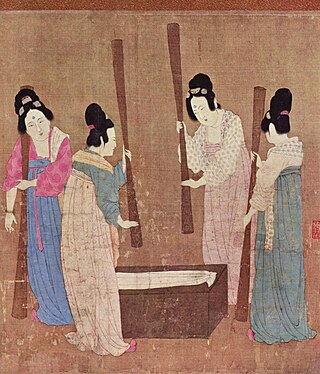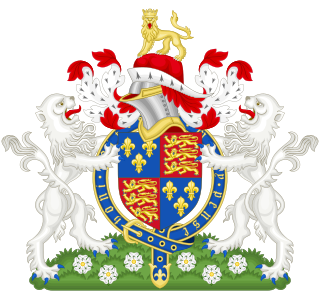
Calico is a heavy plain-woven textile made from unbleached, and often not fully processed, cotton. It may also contain unseparated husk parts. The fabric is far coarser than muslin, but less coarse and thick than canvas or denim. However, it is still very cheap owing to its unfinished and undyed appearance.
The Navigation Acts, or more broadly the Acts of Trade and Navigation, were a long series of English laws that developed, promoted, and regulated English ships, shipping, trade, and commerce between other countries and with its own colonies. The laws also regulated England's fisheries and restricted foreign—including Scottish and Irish—participation in its colonial trade. While based on earlier precedents, they were first enacted in 1651 under the Commonwealth.

Poplin, also called tabinet, is a fine wool, cotton or silk fabric that has a vertical warp and a horizontal weft. Nowadays, the name refers to a strong material in a plain weave of any fiber or blend, with crosswise ribs that typically give a corded surface.

Game laws are statutes which regulate the right to pursue and hunt certain kinds of wild animals and fish. The scope of game laws can include the following:

Murshidabad district is a district in the Indian state of West Bengal. Situated on the left bank of the river Ganges, the district is very fertile. Covering an area of 5,341 km2 (2,062 sq mi) and having a population 7.103 million, it is a densely populated district and the ninth most populous in India. Berhampore city is the headquarters of the district.
The Spitalfield riots occurred between 1765 and 1769, during a downturn in the silk weaving industry, centred on Spitalfields in the East End of London. The weavers organised to attempt to ensure that the rates of pay paid for their piece work was not cut beneath the level at which they could feed themselves, and their families.

The production of silk originated in Neolithic China within the Yangshao culture. Though it would later reach other places in the world, the art of silk production remained confined to China until the Silk Road opened at 114 BC, though China maintained its virtual monopoly over silk production for another thousand years. The use of silk within China was not confined to clothing alone, and silk was used for a number of applications, such as writing. Within clothing, the color of silk worn also held social importance, and formed an important guide of social class during the Tang dynasty.
Events from the year 1455 in England.

The Non-Importation Act, passed by the United States Congress on April 18, 1806, forbid any kind of import of certain British goods in an attempt to coerce Britain to suspend its impressment of American sailors and to respect American sovereignty and neutrality. The Act was the first in a series of ineffective attempts of Congress and the administrations of President Thomas Jefferson and James Madison to respond economically, instead of militarily, to these British actions and to other consequences of the Napoleonic Wars. The Act was part of the chain of events leading to the War of 1812.

China is the world's largest and earliest silk producer. The vast majority of Chinese silk originates from the mulberry silkworms. During the larval stage of its life cycle, the insects feed on the leaves of mulberry trees. Non-mulberry silkworm cocoon production in China primarily focuses on wild silk from the Chinese Tussah moth. This moth typically feeds on trees and its larvae spin coarser, flatter, yellower filament than the mulberry silkworms.

The Calico Acts banned the import of most cotton textiles into England, followed by the restriction of sale of most cotton textiles. It was a form of economic protectionism, largely in response to India, which dominated world cotton textile markets at the time. The Acts were a precursor to the Industrial Revolution, when Britain eventually surpassed India as the world's leading textile manufacturer in the 19th century.

The economy of the Ming dynasty (1368–1644) of China was one of the largest in the world during that period. It is regarded as one of China's three major golden ages. The period was marked by the increasing political influence of the merchants, the gradual weakening of imperial rule, and technological advances.

Indienne, was a type of printed or painted textile manufactured in Europe between the 17th and the 19th centuries, inspired by similar textile originally made in India. They received various other names in French such as madras, pékin, perse, gougouran, damas, and cirsacs. The original Indian techniques for textile printing involved long and complicated processes necessitating the use of mordants or metallic salts to fix the dyes. The beautiful, vibrant, colors came from the garance plant for red, indigo for blue, and gaude for yellow.

The Bengal Subah, also referred to as Mughal Bengal, was the largest subdivision of Mughal India encompassing much of the Bengal region, which includes modern-day Bangladesh and the Indian state of West Bengal, and some regions from the Indian states of Bihar, Jharkhand, Odisha between the 16th and 18th centuries. The state was established following the dissolution of the Bengal Sultanate, a major trading nation in the world, when the region was absorbed into the Mughal Empire. Bengal was the wealthiest region in the Indian subcontinent.
The textile industry in India traditionally, after agriculture, is the only industry that has generated huge employment for both skilled and unskilled labour. The textile industry continues to be the second-largest employment generating sector in India. It offers direct employment to over 35 million people in the country. India is the world's second largest exporter of textiles and clothing, and in the fiscal year 2022, the exports stood at US$ 44.4 billion. According to the Ministry of Textiles, the share of textiles in total exports during April–July 2010 was 11.04%. During 2009–2010, the Indian textile industry was pegged at US$55 billion, 64% of which services domestic demand. In 2010, there were 2,500 textile weaving factories and 4,135 textile finishing factories in all of India. According to AT Kearney’s ‘Retail Apparel Index’, India was ranked as the fourth most promising market for apparel retailers in 2009.

The Importation Act 1455 was an act of the Parliament of England passed during the reign of Henry VI.

The Importation Act 1463 was an Act of the Parliament of England passed during the reign of Edward IV.

The Importation Act 1337 was an Act of the Parliament of England passed during the reign of Edward III.

The Importation of Silk Act 1463 was an Act of the Parliament of England passed during the reign of Edward IV.















